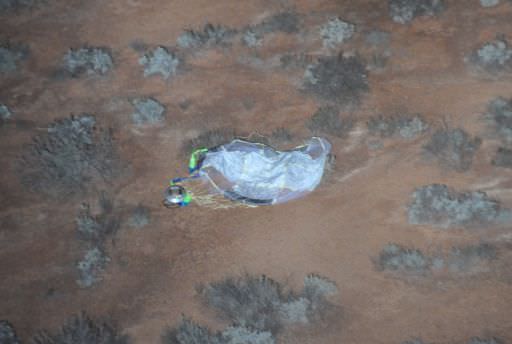[/caption]
Scientists from Japan were given the go-ahead to retrieve the sample return capsule from the Hayabusa spacecraft, which is hoped to contain the first piece of asteroid ever brought to Earth, perhaps providing insight into the origins of asteroids – and our universe. The capsule was ejected three hours before reaching Earth, and the sample canister descended through Earth's atmosphere, preceding the spacecraft which broke up in spectacular fashion (
click here to see the video
) over the Australian Outback. The capsule lay in the Woomera Prohibited Area until morning when Aboriginal elders deemed it had not landed in any indigenous sacred sites, giving the OK for the scientists to retrieve it.
The insulated and cushioned re-entry capsule, 40 cm in diameter and 25 cm deep has a mass of about 20 kg. The capsule had a convex nose covered with a 3 cm thick ablative heat shield to protect the samples from the high velocity (~13 km/s) re-entry.
Apparently, it landed right on target. The director of the Woomera test range, Doug Gerrie, said the probe had completed a textbook landing in the South Australian desert. "They landed it exactly where they nominated they would. [caption id="attachment_66341" align="aligncenter" width="580" caption="Hayabusa's heat shield was also recovered from the Australian outback. Credit: JAXA"]
[/caption] The capsule will remain sealed until it arrives at the JAXA facility near Tokyo, and may remain unopened for weeks as it undergoes testing.
The mission launched in 2003, and endured a series of technical glitches over its five-billion-kilometer (three-billion-mile) journey to the asteroid Itokawa and back. A large solar flare in late 2003 "injured" the solar panels, providing less power to Hayabusa's ion engines, delaying the rendezvous with the asteroid. Then, as the spacecraft approached Itokawa, Hayabusa lost the use of its Y-axis reaction wheel. While it flew near the asteroid and sent back data, scientists and engineers aren't sure if the spacecraft was successful in obtaining samples, as while it appears Hayabusa landed briefly, it is not certain the "bullets" fired to stir up dust for the container to capture. The return to Earth was delayed by three years from more thruster and navigational failures, but the JAXA team nursed and coaxed the spacecraft back home to a spectacular return. There was concern that the parachute batteries may be been depleted due to the extra time it took to get back to Earth, but obviously they worked quite well.
Sources: JAXA,
NASA,
AFP
 Universe Today
Universe Today
